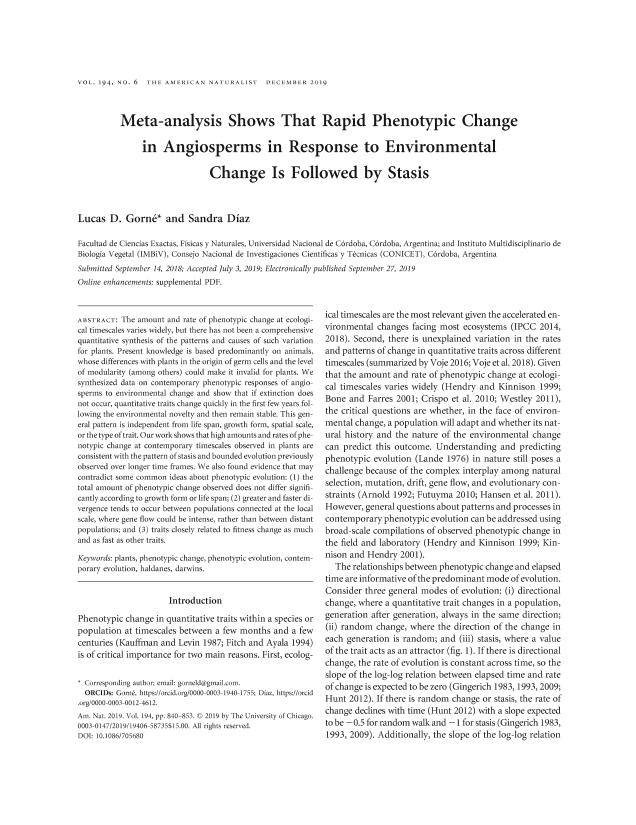Mostrar el registro sencillo del ítem
dc.contributor.author
Gorne, Lucas Damián

dc.contributor.author
Díaz, Sandra Myrna

dc.date.available
2020-08-06T19:04:05Z
dc.date.issued
2019-12
dc.identifier.citation
Gorne, Lucas Damián; Díaz, Sandra Myrna; Meta-analysis shows that rapid phenotypic change in angiosperms in response to environmental change is followed by stasis; University of Chicago Press; American Naturalist; 194; 6; 12-2019; 840-853
dc.identifier.issn
0003-0147
dc.identifier.uri
http://hdl.handle.net/11336/111082
dc.description.abstract
The amount and rate of phenotypic change at ecological timescales varies widely, but there has not been a comprehensive quantitative synthesis of the patterns and causes of such variation for plants. Present knowledge is based predominantly on animals, whose differences with plants in the origin of germ cells and the level of modularity (among others) could make it invalid for plants. We synthesized data on contemporary phenotypic responses of angiosperms to environmental change and show that if extinction does not occur, quantitative traits change quickly in the first few years following the environmental novelty and then remain stable. This general pattern is independent from life span, growth form, spatial scale, or the type of trait. Our work shows that high amounts and rates of phenotypic change at contemporary timescales observed in plants are consistent with the pattern of stasis and bounded evolution previously observed over longer time frames. We also found evidence that may contradict some common ideas about phenotypic evolution: (1) the total amount of phenotypic change observed does not differ significantly according to growth form or life span; (2) greater and faster divergence tends to occur between populations connected at the local scale, where gene flow could be intense, rather than between distant populations; and (3) traits closely related to fitness change as much and as fast as other traits.
dc.format
application/pdf
dc.language.iso
eng
dc.publisher
University of Chicago Press

dc.rights
info:eu-repo/semantics/openAccess
dc.rights.uri
https://creativecommons.org/licenses/by-nc-sa/2.5/ar/
dc.subject
CONTEMPORARY EVOLUTION
dc.subject
DARWINS
dc.subject
HALDANES
dc.subject
PHENOTYPIC CHANGE
dc.subject
PHENOTYPIC EVOLUTION
dc.subject
PLANTS
dc.subject.classification
Biología

dc.subject.classification
Ciencias Biológicas

dc.subject.classification
CIENCIAS NATURALES Y EXACTAS

dc.title
Meta-analysis shows that rapid phenotypic change in angiosperms in response to environmental change is followed by stasis
dc.type
info:eu-repo/semantics/article
dc.type
info:ar-repo/semantics/artículo
dc.type
info:eu-repo/semantics/publishedVersion
dc.date.updated
2020-07-20T15:51:17Z
dc.identifier.eissn
1537-5323
dc.journal.volume
194
dc.journal.number
6
dc.journal.pagination
840-853
dc.journal.pais
Estados Unidos

dc.description.fil
Fil: Gorne, Lucas Damián. Consejo Nacional de Investigaciones Científicas y Técnicas. Centro Científico Tecnológico Conicet - Córdoba. Instituto Multidisciplinario de Biología Vegetal. Universidad Nacional de Córdoba. Facultad de Ciencias Exactas Físicas y Naturales. Instituto Multidisciplinario de Biología Vegetal; Argentina
dc.description.fil
Fil: Díaz, Sandra Myrna. Consejo Nacional de Investigaciones Científicas y Técnicas. Centro Científico Tecnológico Conicet - Córdoba. Instituto Multidisciplinario de Biología Vegetal. Universidad Nacional de Córdoba. Facultad de Ciencias Exactas Físicas y Naturales. Instituto Multidisciplinario de Biología Vegetal; Argentina
dc.journal.title
American Naturalist

dc.relation.alternativeid
info:eu-repo/semantics/altIdentifier/doi/http://dx.doi.org/10.1086/705680
dc.relation.alternativeid
info:eu-repo/semantics/altIdentifier/url/https://www.journals.uchicago.edu/doi/10.1086/705680
Archivos asociados
